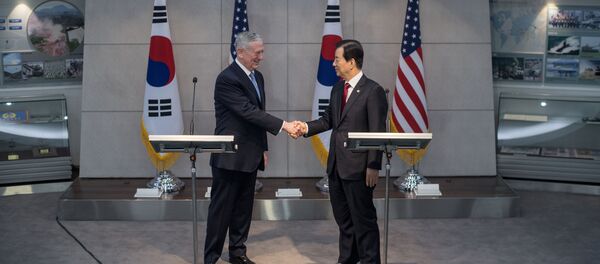Figures for 2016 show that the DPRK has an estimated 54 kilograms of plutonium and 758 kilograms (.83 tons) of highly-enriched uranium, according to South Korean news outlet JoongAng Ilbo.
Previously, defense experts estimated that Pyongyang possessed around 40-50 kilograms of plutonium, and 300-400 kilograms of highly-enriched uranium.
Producing a nuclear warhead requires 16-20 kilograms of highly-enriched uranium, and between four to six kilograms of plutonium, according to estimations from US and South Korean military experts. Around six kilograms of plutonium were used to make the atomic bomb dropped on Nagasaki during World War II.
Last year, Seoul and Washington shared intelligence indicating that the DPRK was expanding its uranium enrichment facility in the North Pyongan Province at Yongbyon, and calculated the amount of nuclear material Pyongyang was using.
Officials from the two countries reasoned that the growth in Pyongyang’s nuclear stockpile could be attributed to a new, secret facility. They believe this clandestine base is also located in North Pyongan province, near the Panghyon air base in Kusong.
South Korean intelligence officials believe the North is hiding more facilities, as centrifuges used for uranium production only require about 600 square meters, although larger facilities are typically needed to produce plutonium.
The Yongbyon nuclear complex houses a uranium centrifuge facility where Pyongyang produces highly-enriched uranium, along with a 5-megawatt reactor where plutonium is reprocessed.
Experts believe that there could be a second, and possibly a third, facility, as Yongybon alone is not thought to be able to produce the reported 758 kilograms of weapon-grade uranium, especially as previous estimates show the facility producing only 300-400 kilograms since 2005.
An unnamed intelligence source was quoted as saying, "A second facility [for uranium enrichment] definitely exists."
One intelligence official in Seoul told JoongAng Ilbo, "South Korea and the United States have been continuously tracking the trend of North Korea’s facilities that produce nuclear materials…And they concluded that the amount of nuclear materials possessed by North Korea far exceeds the amount estimated by experts."
Science and Technology Policy Institute research fellow Lee Chun-geun said, "Highly-enriched uranium can be mass produced for relatively little cost, and 1,000 centrifuges can be operated in a relatively small amount of space of around 600 square meters, so it is easy to conceal."
Lee was quoted by Yonhap News Agency telling a conference that "North Korea appears to have used HEU in its fifth nuclear test [last September], and the demonstration of a relatively strong explosive power can mean the country has produced enough HEU."
At the time, South Korean President Park Geun-hye cut an overseas trip short in response to the launch, calling it a “grave challenge” and warning that, "Such provocation will further accelerate its path to self-destruction.






